The Ultimate Headphone Guide for Podcasting 2025
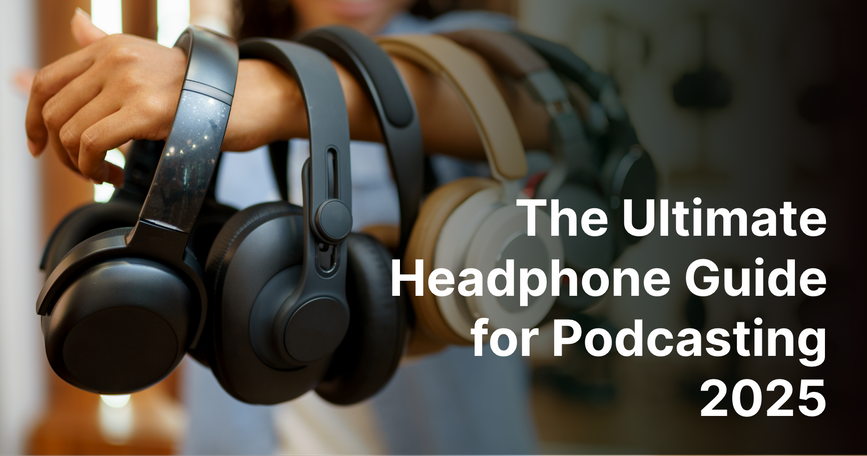
Sound quality is the foundation of a successful podcast. It is key to capturing and holding your audience's attention, enriching the listening experience, and ensuring your message comes through loud and clear.
For podcasters, the right headphones can elevate your podcasting experience and ensure your audience enjoys a smooth, professional audio experience every time.
Why are headphones essential for podcasting?
What factors should I consider when choosing the right pair?
What are the recommended headphones for podcasting?
In this guide, we’ll help you navigate through the world of podcasting headphones, from understanding the different types available to considering key factors like sound quality, comfort, and durability.
Types of Headphones for Podcasting
Choosing the right type of headphones is crucial for ensuring the best podcasting experience. Different styles offer unique benefits, depending on your recording environment and needs.
Here’s a breakdown of the four main types of headphones that are popular among podcasters:
Over-Ear Headphones
- Best for : Studio recording, long editing sessions, and podcasters who need superior sound isolation.
- Key features : Fully cover the ears to block out external noise, providing the best sound quality and detailed audio.
Over-ear headphones are a go-to choice for many podcasters, especially those who work in studio settings.
If you’re planning on long recording or editing sessions, over-ear headphones are also known for their superior comfort, offering more padding and better ergonomics for extended wear.
On-Ear Headphones
- Best for : Portability and podcasters who want a lightweight option for shorter recording or editing sessions.
- Key features : Rest on the ears rather than covering them, making them more compact and less bulky than over-ear models.
Unlike over-ear headphones, these rest on top of the ears rather than surrounding them, making them more compact and less bulky. However, they don’t provide the same level of isolation as over-ear headphones.
In-Ear Monitors (IEMs)
- Best for : Podcasters who need portability or often record in tight spaces.
- Key features : Small, portable earbuds that fit directly into the ear canal, providing a secure fit and good isolation.
Though In-ear monitors (IEMs) are less common than over-ear and on-ear headphones, many podcasters prefer IEMs for their portability and comfort during short recording sessions.
Headsets vs. Headphones
When choosing between a headset and headphones , it comes down to convenience versus flexibility.
A headset combines both headphones and a microphone into one unit. It is ideal for those who want simplicity, but the microphone quality may not match that of a dedicated mic.
On the other hand, headphones focus solely on audio quality and require a separate microphone. This setup offers more flexibility and allows you to choose a high-quality mic that suits your needs.
Key Factors to Consider When Selecting Podcasting Headphones
Before diving into the discussion, remember that preferences for equipment are very personal. Ultimately, choose what suits you best and feels most comfortable.
Several key factors should guide your decision-making process, ensuring that the headphones you select deliver the best sound quality, comfort, and durability for your workflow.
Sound Quality
This is the most important factor for any podcaster. The headphones you choose need to reproduce sound accurately, with clear dialogue and crisp audio. Look for a wide frequency response, good sound detail , and excellent clarity to ensure you can hear every nuance of your recordings.
Comfort
Since podcasting often involves long hours of recording and editing, comfort is a must. Consider factors like earcup material, padding, weight , and overall design . You’ll want headphones that feel comfortable for extended use without causing discomfort or fatigue, so you can focus on producing high-quality content without distraction.
Sound Isolation
Effective sound isolation helps minimize distractions from external noise, ensuring you can focus entirely on your audio. Whether you're recording in a busy environment or editing in a noisy room, good isolation helps you hear every detail of your sound without interference.
Durability
Podcasting equipment takes a lot of wear and tear, especially if you're frequently on the go. Durability matters, particularly for headphones that you'll be using daily. Look for well-built models made of quality materials that can withstand the rigors of travel, frequent use, and accidental bumps.
Brand Reputation
Lastly, always consider the brand. Well-established brands with a reputation for high-quality audio gear tend to offer more reliable products, better customer service, and longer-lasting performance. Look for brands known for producing durable, high-performing audio equipment, as this can save you time and money in the long run.
Wired vs Wireless Headphones?
While wireless headphones are convenient, it's important to recognize that sound transmission is more efficient through a wired connection . Even the most advanced manufacturers cannot override the laws of physics to make wireless sound travel faster than its wired counterpart.
Wireless headphones often have a slight delay, which can cause audio to lag behind what you hear. This latency, along with the fact that many wireless headphones are heavier, makes wired headphones a preferred choice for many podcasters . Although they limit your movement, the lack of audio delay makes them a more reliable option for recording.
Open-Back vs Closed-Back Headphones?
Open-back headphones let air and noise pass through, which is good for gaming but not good for podcasts because it can cause noises to escape and mix with your recording.
Podbean recommends that podcasters choose closed-back headphones over open-back ones. Closed-back headphones have closed cups that keep sounds from getting out.
List of Top Headphones for Podcasting in 2025
Our selection of headsets consists exclusively of closed-back, wired headphones from reputable brands, all offering a suitable frequency range for spoken word audio.
To help you find the best fit, we have categorized these options into three distinct price brackets to cater to various budgets. You can find these headphones readily available for purchase on Amazon.
Top Picks Under $100
Audio Technica m20x Podbean's Top Pick

- Price : Around $48 USD (prices may vary by retailer).
- Type : Closed-back, over-ear headphones.
- Comfort : Cushioned ear cups and adjustable headband for comfortable, extended wear.
- Frequency Response: 20 Hz – 20 kHz
- Sensitivity: 96 dB
- Impedance: 32 ohms
The Audio-Technica ATH-M20x is a top choice for entry-level podcasting, offering solid sound quality and comfort at an affordable price.
As part of the renowned M-Series, it delivers clear, balanced audio, making it ideal for reliable voice monitoring. The headphones feature durable construction and comfortable ear cups , ensuring they withstand long recording sessions while providing a secure, comfortable fit.
Its lightweight design makes it easy to wear for extended periods, while the wide frequency response ensures accurate sound reproduction for all podcasting needs.
Sony MDR7506/1

- Price : Around $99 USD (prices may vary by retailer).
- Type : Closed-back, over-ear headphones.
- Comfort : Lightweight design with cushioned ear pads for comfortable extended use.
- Frequency Response: 10 Hz – 20 kHz
- Sensitivity: 106 dB
- Impedance: 63 ohms
The Sony MDR-7506/1 is a highly regarded headphone in the podcasting and audio professional world, known for its precise sound reproduction driven by a 40mm driver.
It excels at accurately representing mid and high frequencies, making it ideal for detailed voice monitoring, editing, and mixing. The headphones feature comfortable padded ear cups for long listening sessions, a coiled cable to minimize tangling and offer flexibility, and a foldable design for easy packing and portability. Its durable frame ensures long-lasting performance, even with frequent use.
While the MDR-7506/1 benefits from Sony’s solid reputation and delivers reliable performance, it lacks standout innovations or unique features compared to other headphones in its price range.
Sennheiser 280 PRO

- Price : Around $99 USD (prices may vary by retailer).
- Type : Closed-back, over-ear headphones.
- Comfort : Lightweight design with plush ear padding for long-lasting comfort during extended sessions.
- Frequency Response: 8 Hz – 25 kHz
- Sensitivity: 113 dB
- Impedance: 64 ohms
If you're hesitant about the Sony option but are looking to keep within a budget of around $100, the Sennheiser HD 280 Pro could be a suitable alternative to consider.
The Sennheiser HD 280 PRO offers superior noise isolation with thicker ear padding, making it ideal for noisy environments. The sound is more balanced and natural , with better bass response, making it suitable for long mixing sessions. The HD 280 PRO also provides greater comfort with larger ear cups and better cushioning.
Additionally, it has a more durable build and offers a wider soundstage for more accurate monitoring.
Top Picks Under $200
Shure SRH840

- Price : Around $129 USD (prices may vary by retailer).
- Type : Closed-back, over-ear headphones.
- Comfort : Padded ear cups and an adjustable headband for a comfortable fit during long listening or recording sessions.
- Frequency Response: 5 Hz – 25 kHz
- Sensitivity: 98 dB
- Impedance: 44 ohms
The SRH840 provides detailed, clear audio with an emphasis on accurate midrange and bass response , making it ideal for podcasters who need precision in voice monitoring and fine-tuning their recordings.
Its balanced sound signature ensures that vocals come through clearly while maintaining depth in the low-end. The headphones offer exceptional comfort with a padded headband and memory foam ear cups , designed to minimize discomfort during extended recording or editing sessions.
Built to last, the SRH840 features a detachable coiled cable that reduces tangling and allows for flexible movement in studio settings, as well as a foldable design for easy storage and portability.
Audio Technica ATH-M50X
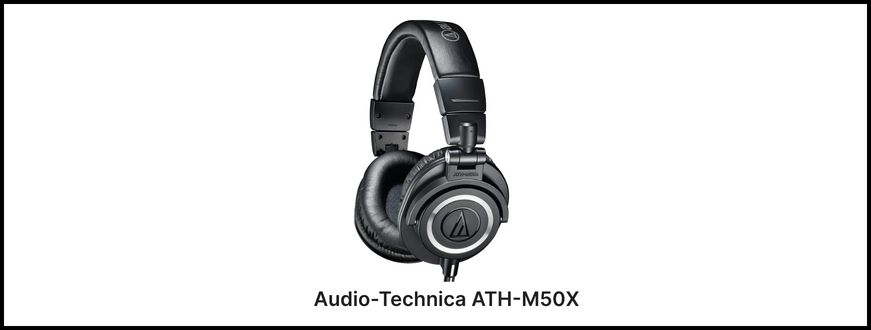
- Price : Around $169 USD (prices may vary by retailer).
- Type : Closed-back, over-ear headphones.
- Comfort : Soft, cushioned ear cups and a self-adjusting headband for a secure and comfortable fit, even during long listening sessions.
- Frequency Response: 15 Hz – 28 kHz
- Sensitivity: 99 dB
- Impedance: 38 ohms
The Audio-Technica ATH-M50X, the top-tier model in the M-series, delivers crisp, accurate sound with a slight bass boost . It’s durable, foldable design ensures comfort and portability, while detachable cables add versatility. With excellent noise isolation , it provides an immersive listening experience, making it a favorite among both professionals and audiophiles.
That said, the M50X lacks active noise cancellation and has a tight fit that may cause discomfort over long sessions. Its slightly boosted bass and narrow soundstage might not suit all listeners.
AKG Pro Audio K371

- Price : Around $149 USD (prices may vary by retailer).
- Type : Closed-back, over-ear headphones.
- Comfort : Lightweight and ergonomic design with plush ear pads and a comfortable headband for long listening or recording sessions.
- Frequency Response: 5 Hz – 40 kHz
- Sensitivity: 114 dB
- Impedance: 32 ohms
The AKG K371 is a top-tier choice for podcasters who demand precise, professional sound.
The balanced sound profile delivers an accurate, natural listening experience for confident editing, while the lightweight design and memory foam ear pads ensure all-day comfort during long sessions.
Noise isolation is another standout feature, ensuring you stay immersed in your content without distractions. It's lighter, more compact, and foldable for easy portability.
Beyerdynamic DT 770 Pro
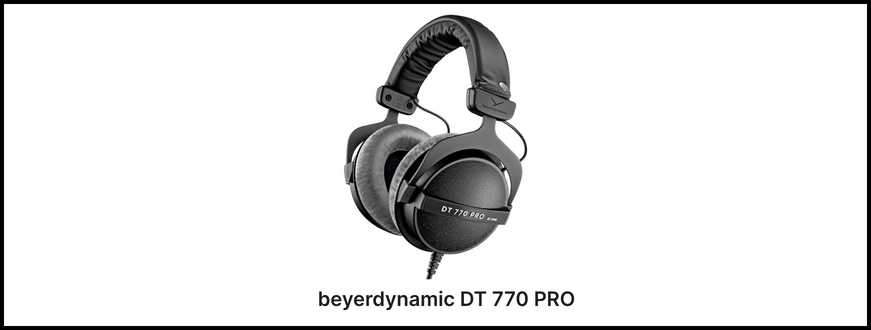
- Price : Around $149 USD (prices may vary by retailer).
- Type : Closed-back, over-ear headphones.
- Comfort : Lightweight and ergonomic design with plush ear pads and a comfortable headband for long listening or recording sessions.
- Frequency Response: 5 Hz – 35 kHz
- Sensitivity: 96 dB
- Impedance : Available in multiple versions: 32 ohms , 80 ohms , and 250 ohms
The Beyerdynamic DT 770 Pro is ideal for podcasters and audio professionals, offering exceptional sound precision and clarity with stunning detail in vocals, music, and sound effects.
The DT 770 Pro's over-ear design with velour pads ensures comfort during long sessions, while the single-sided cable reduces tangling for easy mobility. Built with durable German engineering , it's perfect for heavy use in studios or on-location.
Though less portable than the AKG K371, the DT 770 Pro excels in studio settings, offering professional-grade sound precision , durability, and long-session comfort—making it a smart investment.
Top Picks Under $500
V-MODA Crossfade M-100
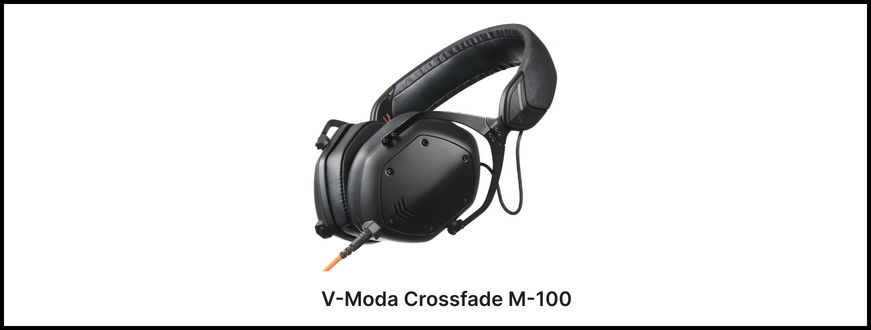
- Price : Around $230 USD (prices may vary by retailer).
- Type : Over-ear, closed-back headphones.
- Comfort : Memory foam ear cushions and a durable headband designed for a comfortable and secure fit during long sessions.
- Frequency Response: 5 Hz – 30 kHz
- Sensitivity: 103 dB
- Impedance: 32 ohms
The V-MODA Crossfade M-100 is an excellent choice for podcasting, offering a clear sound profile with punchy bass , crisp highs , and detailed mids .
With memory foam ear cushions for comfort and a durable steel frame for reliability, the foldable design and portable case make it perfect for podcasters needing a rugged, high-performance headset for both studio and on-the-go use.
The V-MODA Crossfade M-100 may feel a bit tight for some users, potentially causing discomfort during extended listening sessions. Additionally, its bass-heavy sound may not be ideal for podcasters seeking a more neutral, balanced audio profile for precise editing.
Audio-Technica ATH-M70x
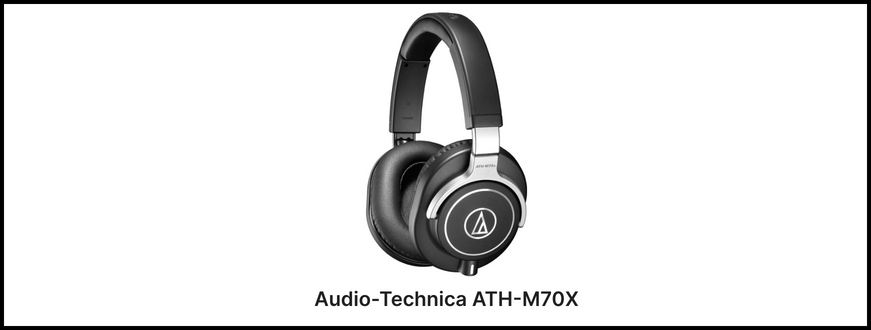
- Price : Around $349 USD (prices may vary by retailer).
- Type : Closed-back, over-ear headphones.
- Comfort : Soft, memory foam ear pads and an adjustable headband for long-lasting comfort during extended listening or studio sessions.
- Frequency Response: 5 Hz – 40 kHz
- Sensitivity: 99 dB
- Impedance: 35 ohms
The Audio-Technica ATH-M70x stands out with its exceptional build quality and precise sound reproduction , making it a top choice for both audio professionals and podcasters. Its unmatched clarity and accuracy ensure that every detail of speech is captured.
Its deep, well-balanced bass and crisp treble ensure that voices are clear and natural, making it easier to mix and edit podcast audio. With a comfortable, adjustable fit and durable construction, the ATH-M70x provides long-lasting performance for both casual podcasters and professionals alike.
However, its slightly bulkier design provides good comfort and noise isolation but is less portable.
Shure SRH 1540

- Price : Around $499 USD (prices may vary by retailer).
- Type : Closed-back, over-ear headphones.
- Comfort : Memory foam ear pads and a lightweight aluminum frame for a comfortable, secure fit during extended use.
- Frequency Response: 5 Hz – 25 kHz
- Sensitivity: 99 dB
- Impedance: 46 ohms
The Shure SRH 1540 is a high-end headphone known for its detailed, well-balanced sound profile and superior comfort . It delivers accurate sound reproduction, ideal for podcasters who need to monitor voice recordings and edits with clarity.
The headphones are also foldable and come with a carrying case, making them relatively portable without sacrificing comfort or durability.
However, the Shure SRH 1540 can feel a bit bulky for some users, while being relatively expensive for its class.
Conlusion
Choosing the perfect headphones for podcasting can feel like finding the secret ingredient that transforms good content into great content.
It’s not just about hearing every detail clearly—it’s about having a tool that enhances your recording, makes editing easier, and keeps you comfortable through hours of creative flow.
The Audio-Technica M20x is the top budget choice, offering clear sound and comfort. The Sony MDR7506/1 and Sennheiser 280 PRO are solid professional options, while the ATH-M50X and Shure SRH840 provide a balanced sound with extra bass. For most podcasters, the M20x strikes the best balance of performance and affordability.
For detailed, analytical sound, the AKG K371, Audio-Technica ATH-M70X, and Shure SRH 1540 are perfect for editing. The Beyerdynamic DT 770 Pro offers great comfort and noise isolation, while the V-MODA Crossfade M-100 delivers a stylish, bass-heavy sound for an energetic audio experience.
At the end of the day, the best headphones for podcasting are the ones that fit your unique style and needs. Once you've picked the perfect headphones to suit your needs, it's time to hit record and start creating your podcast!
Frequently Asked Questions (FAQs)
What makes headphones ideal for podcasting?
The best headphones for podcasting typically offer clear, detailed sound, excellent noise isolation, comfort for long sessions, and durability. A good balance between bass, midrange, and treble is also essential for accurate monitoring and editing.
Do I need expensive headphones to start podcasting?
Not necessarily! While higher-end models offer enhanced sound quality and comfort, there are plenty of affordable options that work perfectly for beginner podcasters. Models like the Audio-Technica M20x or Sony MDR7506/1 provide great value without the hefty price tag.
Can I use Bluetooth headphones for podcasting?
While Bluetooth headphones are convenient for casual listening, wired headphones are generally preferred for podcasting because they provide more reliable, lag-free audio. Wired connections also tend to offer better sound quality, especially when monitoring for professional work.
Are noise-canceling headphones necessary for podcasting?
Noise-canceling headphones can help block out unwanted external sounds, but they aren't essential for podcasting. Closed-back headphones generally provide enough isolation to focus on your recordings without distractions.
What’s the best way to test headphones before purchasing?
If possible, listen to them in a quiet space with some reference audio, such as a podcast or a track that you’re familiar with. Pay attention to the balance of sound and comfort—make sure they feel good for long periods and the sound is clear and natural.
What’s the difference between noise isolation and noise-canceling?
Noise isolation means that the headphones physically block external sound, like closed-back headphones. Noise-canceling headphones use technology to actively reduce ambient noise. Both can be useful for podcasting, but noise isolation is typically preferred for creating a quiet, controlled listening environment.
How do I start a podcast?
Starting a podcast is easier than you might think, visit our website at Podbean.com, where you’ll find everything you need!